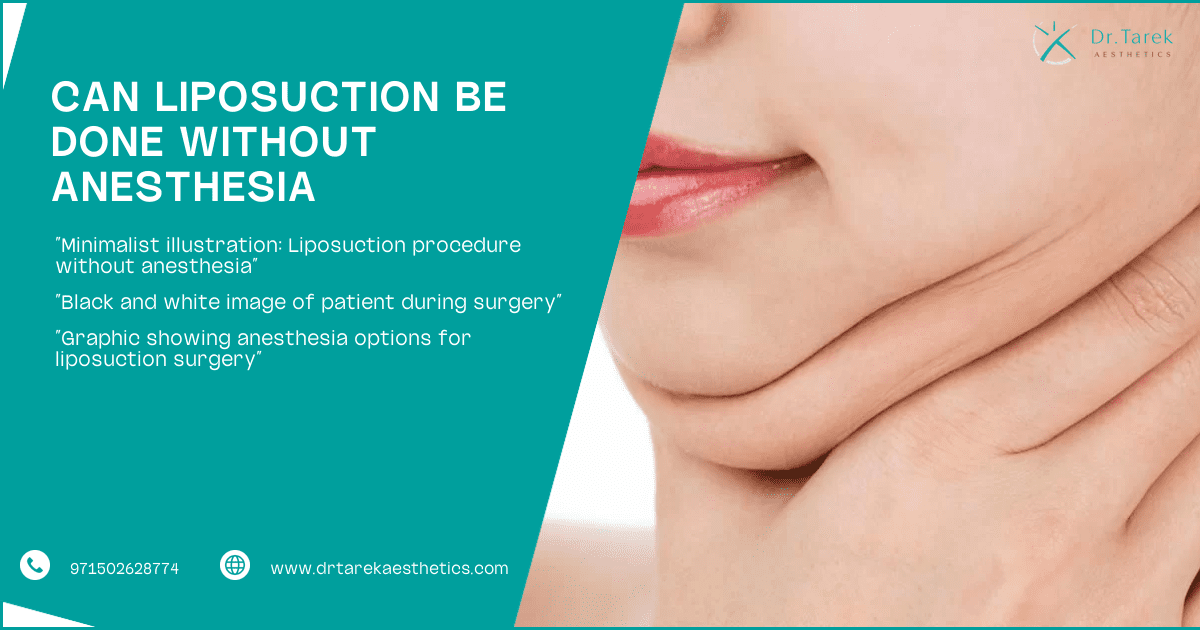Can Liposuction Be Done Without Anesthesia
The Role of Anesthesia in Liposuction
Traditional liposuction procedures typically require anesthesia to ensure patient comfort and safety. Depending on the extent of the procedure and the patient’s health condition, anesthesia can be administered in various forms, including local, regional, or general anesthesia. The primary role of anesthesia is to numb the targeted area, minimize pain, and reduce anxiety during the surgery.
- Local Anesthesia : Used for small areas, allowing the patient to remain awake.
- Regional Anesthesia : Numbs a larger part of the body, such as an entire limb.
- General Anesthesia Puts the patient to sleep and is used for extensive procedures.
Surgical Techniques in Conventional Liposuction
Conventional liposuction involves making small incisions in the skin through which a cannula (a thin tube) is inserted to suction out fat deposits. This surgical technique requires precision and skill to ensure even fat removal and minimize complications. The procedure can be performed on various body parts, including the abdomen, thighs, arms, and buttocks.
- Incisions : Small cuts made in the skin.
- Cannula Insertion : Thin tube used to suction fat.
- Fat Removal : Suctioning out fat deposits.
Non-Surgical Alternatives to Traditional Liposuction
Coolsculpting and Cryolipolysis
Coolsculpting, also known as cryolipolysis, is a non-surgical fat reduction technique that uses controlled cooling to freeze and eliminate fat cells. This method is FDA-approved and is effective for targeting stubborn fat areas without the need for incisions or anesthesia. The body naturally processes and eliminates the dead fat cells over time.
Book A Consultation With Dr Tarek Bayazid
Top-rated Plastic Surgeon For Liposuction in Dubai
Installment Plan Available
- Controlled Cooling : Freezes fat cells.
- Non-Invasive : No incisions or anesthesia required.
- Natural Elimination : The body processes dead fat cells.
Ultrasound-Assisted Fat Reduction
Ultrasound-assisted fat reduction uses high-frequency sound waves to break down fat cells, which are then naturally eliminated by the body. This technique is non-invasive and can be used on various body parts. It is a popular choice for those seeking a non-surgical alternative to liposuction.
- High-Frequency Sound Waves : Breaks down fat cells.
- Non-Invasive : No surgery required.
- Natural Elimination : The body processes broken-down fat cells.
Radiofrequency Treatments for Fat Reduction
Radiofrequency treatments use energy waves to heat and destroy fat cells. This method also stimulates collagen production, which can improve skin elasticity and firmness. Radiofrequency treatments are non-invasive and can be used on multiple body areas.
- Energy Waves : Heat and destroy fat cells.
- Collagen Stimulation : Improves skin elasticity.
- Non-Invasive : No surgery required.
Minimally Invasive Liposuction Techniques
Tumescent Liposuction with Local Anesthesia
Tumescent liposuction involves injecting a large volume of diluted local anesthesia into the fatty tissue before suctioning it out. This technique minimizes blood loss and reduces the need for general anesthesia. Patients remain awake during the procedure, which can be more comfortable for some.
- Diluted Local Anesthesia : Injected into fatty tissue.
- Minimized Blood Loss : Reduces complications.
- Awake Procedure : Patients remain conscious.
Laser-Assisted Liposuction (SmartLipo)
Laser-assisted liposuction, or SmartLipo, uses laser energy to liquefy fat cells before they are suctioned out. This technique allows for more precise fat removal and can also tighten the skin. Local anesthesia is typically used, making it a minimally invasive option.
- Laser Energy : Liquefies fat cells.
- Precise Fat Removal : Allows for targeted treatment.
- Skin Tightening : Improves skin appearance.
Water-Assisted Liposuction (WAL)
Water-assisted liposuction (WAL) uses a gentle, pressurized stream of water to dislodge fat cells, which are then suctioned out. This technique is less traumatic to the surrounding tissues and can be performed under local anesthesia, making it a minimally invasive option.
- Pressurized Water Stream : Dislodges fat cells.
- Less Traumatic : Minimizes tissue damage.
- Local Anesthesia : Patients remain awake.
Is Anesthesia-Free Liposuction Possible
Risks and Limitations of Anesthesia-Free Procedures
While the idea of anesthesia-free liposuction may seem appealing, it comes with significant risks and limitations. Without anesthesia, patients would experience considerable pain and discomfort during the procedure. Additionally, the lack of anesthesia could increase the risk of complications and limit the surgeon’s ability to perform the procedure effectively.
- Pain and Discomfort : High levels without anesthesia.
- Increased Complications : Higher risk without anesthesia.
- Limited Effectiveness : Surgeon constraints.
Patient Comfort and Pain Management Considerations
Patient comfort and pain management are crucial aspects of any liposuction procedure. Even minimally invasive techniques that use local anesthesia prioritize patient comfort. Effective pain management strategies, such as local anesthesia and post-procedure pain relief, are essential for a positive experience and successful outcome.
- Local Anesthesia : Ensures patient comfort.
- Pain Management : Essential for a positive experience.
- Post-Procedure Relief : Important for recovery.
Comparing Surgical and Non-Surgical Fat Reduction Methods
Effectiveness and Results
Surgical liposuction typically provides more immediate and dramatic results compared to non-surgical methods. However, non-surgical alternatives can be effective for those with smaller fat deposits and a preference for less invasive procedures. The choice between surgical and non-surgical methods depends on individual goals and the extent of fat reduction needed.
| Method | Effectiveness | Results Timeline |
| Surgical | High | Immediate |
| Non-Surgical | Moderate | Gradual |
Recovery Time and Downtime
Recovery time and downtime vary significantly between surgical and non-surgical fat reduction methods. Surgical liposuction often requires a longer recovery period, with potential bruising and swelling. Non-surgical methods typically have minimal downtime, allowing patients to return to their daily activities more quickly.
- Surgical Liposuction : Longer recovery, potential bruising.
- Non-Surgical Methods : Minimal downtime, quick return to activities.
Cost Considerations
The cost of fat reduction procedures can vary widely based on the method chosen. Surgical liposuction is generally more expensive due to its complexity and the need for anesthesia. Non-surgical alternatives may be more affordable but may require multiple sessions to achieve desired results.
- Surgical Liposuction : Higher cost, complex procedure.
- Non-Surgical Methods : More affordable, multiple sessions.
The Future of Liposuction Technology
Emerging Techniques in Fat Reduction
The field of fat reduction is continually evolving, with new techniques and technologies emerging. Innovations such as high-intensity focused ultrasound (HIFU) and cryo-electrophoresis are showing promise in providing effective, non-invasive fat reduction options. These advancements aim to improve patient outcomes and reduce recovery times.
- High-Intensity Focused Ultrasound (HIFU) : Emerging technology.
- Cryo-Electrophoresis : Promising non-invasive option.
- Improved Outcomes : Focus on patient satisfaction.
Advancements in Anesthesia-Free Procedures
Advancements in anesthesia-free procedures are being explored to enhance patient comfort and safety. Techniques such as nerve blocks and advanced pain management strategies are being developed to minimize discomfort during fat reduction procedures. These innovations aim to make fat reduction more accessible and comfortable for patients.
- Nerve Blocks : Advanced pain management.
- Minimized Discomfort : Focus on patient comfort.
- Accessibility : Enhancing patient experience.
Choosing the Right Procedure for Your Needs
Consulting with Dr. Tarek
Consulting with a qualified professional like Dr. Tarek is essential for determining the best fat-reduction procedure for your needs. Dr. Tarek can provide personalized recommendations based on your goals, body type, and medical history. A thorough consultation ensures that you make an informed decision.
- Personalized Recommendations : Based on individual needs.
- Body Type and Medical History : Considered in consultation.
- Informed Decision : Ensures best outcomes.
Factors to Consider in Decision-Making
When choosing a fat reduction procedure, several factors should be considered, including the desired results, recovery time, cost, and potential risks. It is essential to weigh the pros and cons of each method and consult with a qualified practitioner to make an informed choice.
- Desired Results : Important for procedure choice.
- Recovery Time : Consider downtime.
- Cost and Risks : Weigh pros and cons.
By understanding the various options available and consulting with a qualified professional, you can make an informed decision about the best fat reduction method for your needs. Whether you opt for traditional liposuction or a non-surgical alternative, prioritizing safety and effectiveness is key to achieving your desired results.
Stats:
1. According to the American Society of Plastic Surgeons, liposuction was the second most popular cosmetic surgical procedure in 2020, with 211,067 procedures performed. (Source: https://www.plasticsurgery.org/news/plastic-surgery-statistics)
2. A study published in the Aesthetic Surgery Journal found that non-invasive body contouring procedures increased by 21% between 2018 and 2019. (Source: https://academic.oup.com/asj/article/40/4/NP148/5728652)
3. The global non-invasive fat reduction market is projected to reach $1.6 billion by 2025, growing at a CAGR of 13.5% from 2020 to 2025. (Source: https://www.grandviewresearch.com/industry-analysis/non-invasive-fat-reduction-market)
FAQ’s
Can liposuction be done without anesthesia?
Liposuction without anesthesia is not recommended due to the significant pain and discomfort it would cause. Anesthesia is essential for ensuring patient comfort and safety during the procedure.
Is there a non-surgical alternative to liposuction?
Yes, there are several non-surgical alternatives to liposuction, including Coolsculpting, ultrasound-assisted fat reduction, and radiofrequency treatments. These methods are effective for reducing fat without the need for surgery.
How painful is liposuction without anesthesia?
Liposuction without anesthesia would be extremely painful and is not a viable option. Anesthesia is used to numb the area and ensure patient comfort during the procedure.
What is the least invasive form of liposuction?
The least invasive form of liposuction is tumescent liposuction with local anesthesia. This technique minimizes blood loss and allows patients to remain awake during the procedure.











Related Posts